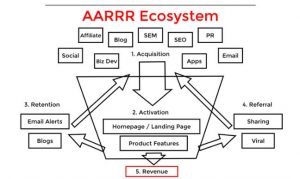Growth hacking, a concept straight from Silicon Valley, is a digital marketing technique. The latter enables start-ups to attract the attention of prospects and generate sales through a combination of innovative strategies, advanced technical skills and data analysis.
The concept was developed in 2010 by Sean Ellis, who used this technique while consulting for companies such as Dropbox, Eventbrite, LogMeIn, and Lookout. This strategy is considered by some experts as an evolution of marketing tailored for technology startups that rely heavily on digital platforms to achieve their growth objectives.

Growth Hacking is also and above all a state of mind as Maxime Salomon, product marketer, states.
“Growth Hacking, before being a multitude of knowledge and skills, is first and foremost a state of mind.”
The roles of the “Growth Hacker
The main responsibility of the “Growth Hacker” is to activate the growth levers within the company he works for. In order to work, the growth hacker must have an almost perfect knowledge of his audience. Based on this, he directs all his actions to generate growth.
The growth hacker uses a range of techniques inspired by marketing and engineering.
- Marketing: for creativity and understanding of customer segments,
- Engineering: for test/process and data analysis.

Generally speaking, the growth hacker has strong marketing and computer skills. However, to be a good growth hacker, you have to be curious. The growth hacker questions everything: he must always test new hypotheses in order to develop effective strategies. There are no right or wrong ways to conduct a successful growth hacking operation. The growth hacker must be open to opportunities to find innovative solutions that will have a positive impact on the company’s growth. Indeed, the growth hacker must often stand out by adopting unconventional strategies in order to have a competitive advantage in his market.

The AARRR scheme
A growth hacker spends a lot of time testing their AARRR (Acquisition, Activation, Retention, Recommendation, Revenue) scheme in order to create growth. The AARRR scheme was shaped by Dave McClure, entrepreneur and business angel.
Let’s look in depth at what the AARRR scheme encompasses:
- Acquisition: provide a strong value proposition to gain the prospect’s attention,
- Activation: transforming the Internet user (the traffic) into a user of the product or service,
- Retention: implementation of tactics to nurture the relationship with the user,
- Recommendation: encourage users to become ambassadors of the product or service to their network,
- Revenue: convert active users into customers and sales.

Brand Content agency, Madalana, in fact, said that “the process must be ‘scalable’ – that is, replicable and scalable on a large scale without requiring proportionate additional human resources.”
Analytics, the sinews of war
The growth hacker uses the data collected to adjust his growth strategy. The best growth hackers take risks to test their hypotheses, but they do so while taking into account the data available to them. In addition, access to a wide range of user information allows the growth hacker to adapt his strategy to each user segment.

In addition, the analytics reflect the performance of the growth hacker. This is the proof of a successful mission or not. The data can be used to learn from a Growth Hacking strategy, the goal being to find the best strategy as soon as possible that will maximize the growth rate for the company.
Some examples of growth hacking
Did you know that Hotmail, Youtube, Twitter, and even Facebook use growth hacking techniques?
- Hotmail was the first company to practice growth hacking. The firm posted the following statement as a signature on its emails in its early years: “PS: I Love You. Get Your Free Email at Hotmail,” to entice recipients to use the service, which earned it 20,000 users in one month, and one million in six months.
- YouTube has managed to surpass MySpace in its early days by offering an “embed code”, allowing you to insert a YouTube video directly on a site or blog.
- Twitter quickly understood that the criterion for retaining new users was their number of followers, which is why each time a user is followed on Twitter, the latter suggests similar profiles to follow.
- Facebook started as a closed network, limited to certain American universities, which allowed it to start with a solid base of already highly interconnected users.
Growth Hacking in Mauritius: a great career opportunity for young people
With the growing number of start-ups in Mauritius, growth hacking has the potential to create new career opportunities. Indeed with the advent of digital marketing in Mauritius, this kind of profile would be a crucial resource within start-ups whose main mission is growth. Note that the growth hacker is a self-taught person who regularly trains on new practices within the industry. The basics of growth hacking can be taught, but there are no university courses on the subject. MOOCs (Massive Open Online Courses) allow you to learn the basics of Growth Hacking. Nevertheless, to become an expert in growth hacking, the only solution is to master the fundamental techniques, then implement them to develop winning strategies.

In Mauritius, this will create new jobs. It is also an opportunity for start-ups to hire young people who will have the right structure to give free rein to their innovative ideas. Furthermore, growth hacking techniques could give ideas to Mauritian companies to create processes internally to streamline the sales and value creation process. There is something for everyone.



